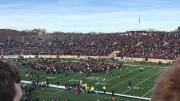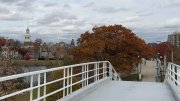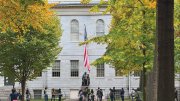The marching bands had just completed their halftime performances at the 2019 iteration of The Game when the real show began.
Somewhere between between 50 and 100 students stormed the field from the Yale Bowl’s south-side end zone, rushing to the “Y” emblem on the 50-yard line. Some sat down while others unfurled banners: “NOBODY WINS: YALE & HARVARD ARE COMPLICIT IN CLIMATE INJUSTICE,” “PRESIDENTS BACOW AND SALOVEY: OUR FUTURE DEMANDS ACTION NOW.”
At first, both teams’ athletes remained on the field, warming up for the second half as if nothing unusual were taking place. But about 10 minutes into the protest, with about a dozen fluorescent-vested police officers flanking the students, the Bulldogs made their way back to their locker room; the Crimson did the same. The crowd largely stood in shock, not sure whether to boo or cheer. “They’re not going to leave until they get arrested,” said a fan on the Yale side.
Gradually more Yale and Harvard students began to join the protestors, skittering onto the field in groups of two or three, largely unobstructed by police or event security.
Then the floodgates opened. Flowing down the aisles and onto the field, hundreds of students from both schools ran toward midfield, expanding the crowd to a length of about 50 yards and, at its thickest, about half the width of the field.
As the mass of students grew larger, it became increasingly unclear whether the game would continue. “Ladies and gentlemen,” pled Yale’s announcer, “as a courtesy to the players, you’re asked to clear the field.” He made this announcement again, and again, and again: “The players must come back on the field.” Some booed, some cheered. His pleas had little effect.
Finally, about a half-hour into the protest, a few dozen police reinforcements entered the stadium. As they threatened to arrest the protestors, a majority of the group headed back toward the stands. The kickers were the first to return to the field, but soon both teams were warming up calmly on opposite sides, sandwiching the remaining student activists for fossil-fuel divestment in between.
Around an hour after the demonstration began, police officers forcibly removed the last of the demonstrators from the field, often two by two. Several left with fists up.
As the second half began, more than an hour after the first ended, it seemed possible that the most memorable moments of this year’s Game had already occurred.









